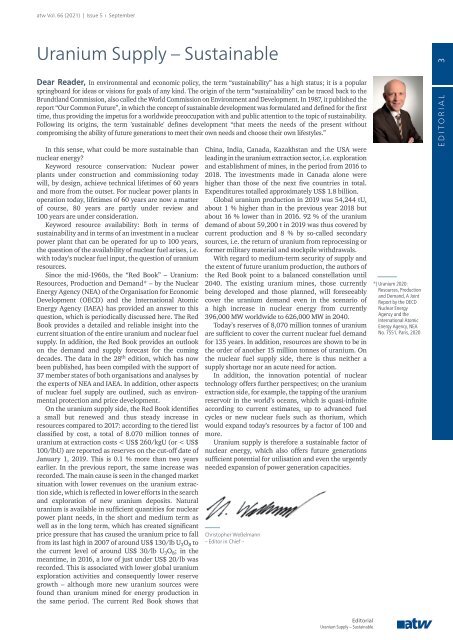atw - International Journal for Nuclear Power | 05.2021
Description Ever since its first issue in 1956, the atw – International Journal for Nuclear Power has been a publisher of specialist articles, background reports, interviews and news about developments and trends from all important sectors of nuclear energy, nuclear technology and the energy industry. Internationally current and competent, the professional journal atw is a valuable source of information. www.nucmag.com
Description
Ever since its first issue in 1956, the atw – International Journal for Nuclear Power has been a publisher of specialist articles, background reports, interviews and news about developments and trends from all important sectors of nuclear energy, nuclear technology and the energy industry. Internationally current and competent, the professional journal atw is a valuable source of information.
www.nucmag.com
Create successful ePaper yourself
Turn your PDF publications into a flip-book with our unique Google optimized e-Paper software.
<strong>atw</strong> Vol. 66 (2021) | Issue 5 ı September<br />
Uranium Supply – Sustainable<br />
3<br />
Dear Reader, In environmental and economic policy, the term “sustainability” has a high status; it is a popular<br />
springboard <strong>for</strong> ideas or visions <strong>for</strong> goals of any kind. The origin of the term “sustainability” can be traced back to the<br />
Brundtland Commission, also called the World Commission on Environment and Development. In 1987, it published the<br />
report “Our Common Future”, in which the concept of sustainable development was <strong>for</strong>mulated and defined <strong>for</strong> the first<br />
time, thus providing the impetus <strong>for</strong> a worldwide preoccupation with and public attention to the topic of sustainability.<br />
Following its origins, the term 'sustainable' defines development “that meets the needs of the present without<br />
compromising the ability of future generations to meet their own needs and choose their own lifestyles.”<br />
In this sense, what could be more sustainable than<br />
nuclear energy?<br />
Keyword resource conservation: <strong>Nuclear</strong> power<br />
plants under construction and commissioning today<br />
will, by design, achieve technical lifetimes of 60 years<br />
and more from the outset. For nuclear power plants in<br />
operation today, lifetimes of 60 years are now a matter<br />
of course, 80 years are partly under review and<br />
100 years are under consideration.<br />
Keyword resource availability: Both in terms of<br />
sustainability and in terms of an investment in a nuclear<br />
power plant that can be operated <strong>for</strong> up to 100 years,<br />
the question of the availability of nuclear fuel arises, i.e.<br />
with today’s nuclear fuel input, the question of uranium<br />
resources.<br />
Since the mid-1960s, the “Red Book” – Uranium:<br />
Resources, Production and Demand* – by the <strong>Nuclear</strong><br />
Energy Agency (NEA) of the Organisation <strong>for</strong> Economic<br />
Development (OECD) and the <strong>International</strong> Atomic<br />
Energy Agency (IAEA) has provided an answer to this<br />
question, which is periodically discussed here. The Red<br />
Book provides a detailed and reliable insight into the<br />
current situation of the entire uranium and nuclear fuel<br />
supply. In addition, the Red Book provides an outlook<br />
on the demand and supply <strong>for</strong>ecast <strong>for</strong> the coming<br />
decades. The data in the 28 th edition, which has now<br />
been published, has been compiled with the support of<br />
37 member states of both organisations and analyses by<br />
the experts of NEA and IAEA. In addition, other aspects<br />
of nuclear fuel supply are outlined, such as environmental<br />
protection and price development.<br />
On the uranium supply side, the Red Book identifies<br />
a small but renewed and thus steady increase in<br />
resources compared to 2017: according to the tiered list<br />
classified by cost, a total of 8.070 million tonnes of<br />
uranium at extraction costs < US$ 260/kgU (or < US$<br />
100/lbU) are reported as reserves on the cut-off date of<br />
January 1, 2019. This is 0.1 % more than two years<br />
earlier. In the previous report, the same increase was<br />
recorded. The main cause is seen in the changed market<br />
situation with lower revenues on the uranium extraction<br />
side, which is reflected in lower ef<strong>for</strong>ts in the search<br />
and exploration of new uranium deposits. Natural<br />
uranium is available in sufficient quantities <strong>for</strong> nuclear<br />
power plant needs, in the short and medium term as<br />
well as in the long term, which has created significant<br />
price pressure that has caused the uranium price to fall<br />
from its last high in 2007 of around US$ 130/lb U 3 O 8 to<br />
the current level of around US$ 30/lb U 3 O 8 ; in the<br />
meantime, in 2016, a low of just under US$ 20/lb was<br />
recorded. This is associated with lower global uranium<br />
exploration activities and consequently lower reserve<br />
growth – although more new uranium sources were<br />
found than uranium mined <strong>for</strong> energy production in<br />
the same period. The current Red Book shows that<br />
China, India, Canada, Kazakhstan and the USA were<br />
leading in the uranium extraction sector, i.e. exploration<br />
and establishment of mines, in the period from 2016 to<br />
2018. The investments made in Canada alone were<br />
higher than those of the next five countries in total.<br />
Expenditures totalled approximately US$ 1.8 billion.<br />
Global uranium production in 2019 was 54,244 tU,<br />
about 1 % higher than in the previous year 2018 but<br />
about 16 % lower than in 2016. 92 % of the uranium<br />
demand of about 59,200 t in 2019 was thus covered by<br />
current production and 8 % by so-called secondary<br />
sources, i.e. the return of uranium from reprocessing or<br />
<strong>for</strong>mer military material and stockpile withdrawals.<br />
With regard to medium-term security of supply and<br />
the extent of future uranium production, the authors of<br />
the Red Book point to a balanced constellation until<br />
2040. The existing uranium mines, those currently<br />
being developed and those planned, will <strong>for</strong>eseeably<br />
cover the uranium demand even in the scenario of<br />
a high increase in nuclear energy from currently<br />
396,000 MW worldwide to 626,000 MW in 2040.<br />
Today’s reserves of 8,070 million tonnes of uranium<br />
are sufficient to cover the current nuclear fuel demand<br />
<strong>for</strong> 135 years. In addition, resources are shown to be in<br />
the order of another 15 million tonnes of uranium. On<br />
the nuclear fuel supply side, there is thus neither a<br />
supply shortage nor an acute need <strong>for</strong> action.<br />
In addition, the innovation potential of nuclear<br />
technology offers further perspectives; on the uranium<br />
extraction side, <strong>for</strong> example, the tapping of the uranium<br />
reservoir in the world’s oceans, which is quasi-infinite<br />
according to current estimates, up to advanced fuel<br />
cycles or new nuclear fuels such as thorium, which<br />
would expand today’s resources by a factor of 100 and<br />
more.<br />
Uranium supply is there<strong>for</strong>e a sustainable factor of<br />
nuclear energy, which also offers future generations<br />
sufficient potential <strong>for</strong> utilisation and even the urgently<br />
needed expansion of power generation capacities.<br />
Christopher Weßelmann<br />
– Editor in Chief –<br />
*) Uranium 2020:<br />
Resources, Production<br />
and Demand, A Joint<br />
Report by the OECD<br />
<strong>Nuclear</strong> Energy<br />
Agency and the<br />
<strong>International</strong> Atomic<br />
Energy Agency, NEA<br />
No. 7551, Paris, 2020<br />
EDITORIAL<br />
Editorial<br />
Uranium Supply – Sustainable

















